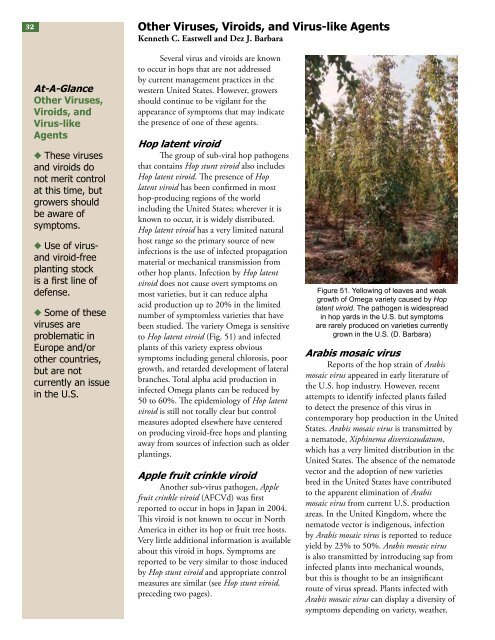Field Guide for Integrated Pest Management in Hops
Field Guide for Integrated Pest Management in Hops
Field Guide for Integrated Pest Management in Hops
Create successful ePaper yourself
Turn your PDF publications into a flip-book with our unique Google optimized e-Paper software.
32Other Viruses, Viroids, and Virus-like AgentsKenneth C. Eastwell and Dez J. BarbaraAt-A-GlanceOther Viruses,Viroids, andVirus-likeAgents◆◆These virusesand viroids donot merit controlat this time, butgrowers shouldbe aware ofsymptoms.◆◆Use of virusandviroid-freeplant<strong>in</strong>g stockis a first l<strong>in</strong>e ofdefense.◆◆Some of theseviruses areproblematic <strong>in</strong>Europe and/orother countries,but are notcurrently an issue<strong>in</strong> the U.S.Several virus and viroids are knownto occur <strong>in</strong> hops that are not addressedby current management practices <strong>in</strong> thewestern United States. However, growersshould cont<strong>in</strong>ue to be vigilant <strong>for</strong> theappearance of symptoms that may <strong>in</strong>dicatethe presence of one of these agents.Hop latent viroidThe group of sub-viral hop pathogensthat conta<strong>in</strong>s Hop stunt viroid also <strong>in</strong>cludesHop latent viroid. The presence of Hoplatent viroid has been confirmed <strong>in</strong> mosthop-produc<strong>in</strong>g regions of the world<strong>in</strong>clud<strong>in</strong>g the United States; wherever it isknown to occur, it is widely distributed.Hop latent viroid has a very limited naturalhost range so the primary source of new<strong>in</strong>fections is the use of <strong>in</strong>fected propagationmaterial or mechanical transmission fromother hop plants. Infection by Hop latentviroid does not cause overt symptoms onmost varieties, but it can reduce alphaacid production up to 20% <strong>in</strong> the limitednumber of symptomless varieties that havebeen studied. The variety Omega is sensitiveto Hop latent viroid (Fig. 51) and <strong>in</strong>fectedplants of this variety express obvioussymptoms <strong>in</strong>clud<strong>in</strong>g general chlorosis, poorgrowth, and retarded development of lateralbranches. Total alpha acid production <strong>in</strong><strong>in</strong>fected Omega plants can be reduced by50 to 60%. The epidemiology of Hop latentviroid is still not totally clear but controlmeasures adopted elsewhere have centeredon produc<strong>in</strong>g viroid-free hops and plant<strong>in</strong>gaway from sources of <strong>in</strong>fection such as olderplant<strong>in</strong>gs.Apple fruit cr<strong>in</strong>kle viroidAnother sub-virus pathogen, Applefruit cr<strong>in</strong>kle viroid (AFCVd) was firstreported to occur <strong>in</strong> hops <strong>in</strong> Japan <strong>in</strong> 2004.This viroid is not known to occur <strong>in</strong> NorthAmerica <strong>in</strong> either its hop or fruit tree hosts.Very little additional <strong>in</strong><strong>for</strong>mation is availableabout this viroid <strong>in</strong> hops. Symptoms arereported to be very similar to those <strong>in</strong>ducedby Hop stunt viroid and appropriate controlmeasures are similar (see Hop stunt viroid,preced<strong>in</strong>g two pages).Figure 51. Yellow<strong>in</strong>g of leaves and weakgrowth of Omega variety caused by Hoplatent viroid. The pathogen is widespread<strong>in</strong> hop yards <strong>in</strong> the U.S. but symptomsare rarely produced on varieties currentlygrown <strong>in</strong> the U.S. (D. Barbara)Arabis mosaic virusReports of the hop stra<strong>in</strong> of Arabismosaic virus appeared <strong>in</strong> early literature ofthe U.S. hop <strong>in</strong>dustry. However, recentattempts to identify <strong>in</strong>fected plants failedto detect the presence of this virus <strong>in</strong>contemporary hop production <strong>in</strong> the UnitedStates. Arabis mosaic virus is transmitted bya nematode, Xiph<strong>in</strong>ema diversicaudatum,which has a very limited distribution <strong>in</strong> theUnited States. The absence of the nematodevector and the adoption of new varietiesbred <strong>in</strong> the United States have contributedto the apparent elim<strong>in</strong>ation of Arabismosaic virus from current U.S. productionareas. In the United K<strong>in</strong>gdom, where thenematode vector is <strong>in</strong>digenous, <strong>in</strong>fectionby Arabis mosaic virus is reported to reduceyield by 23% to 50%. Arabis mosaic virusis also transmitted by <strong>in</strong>troduc<strong>in</strong>g sap from<strong>in</strong>fected plants <strong>in</strong>to mechanical wounds,but this is thought to be an <strong>in</strong>significantroute of virus spread. Plants <strong>in</strong>fected withArabis mosaic virus can display a diversity ofsymptoms depend<strong>in</strong>g on variety, weather,








